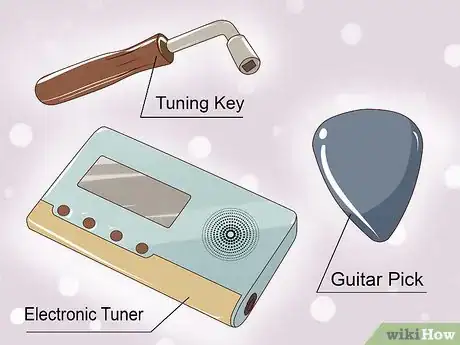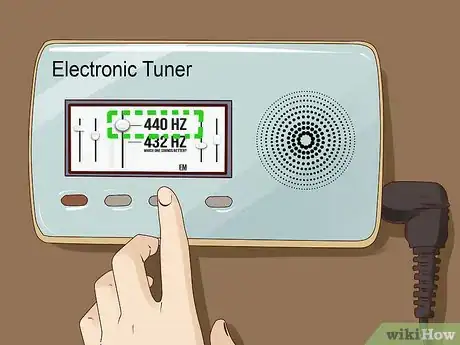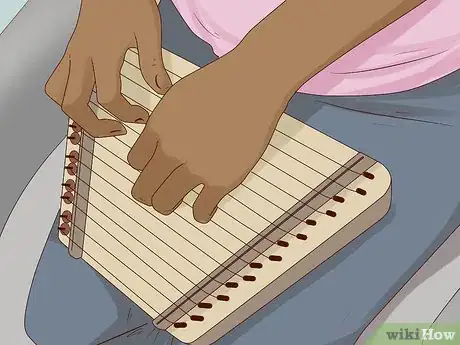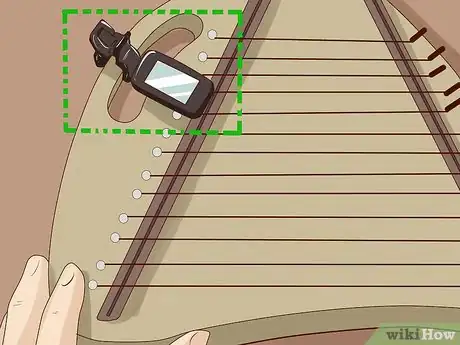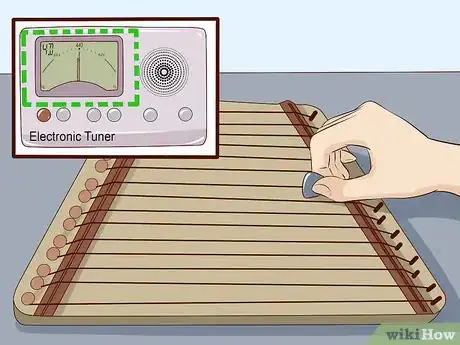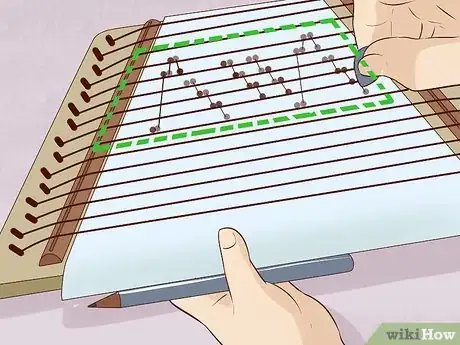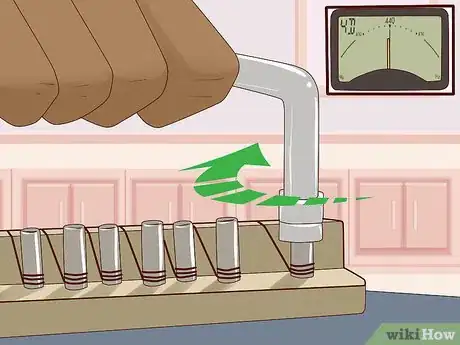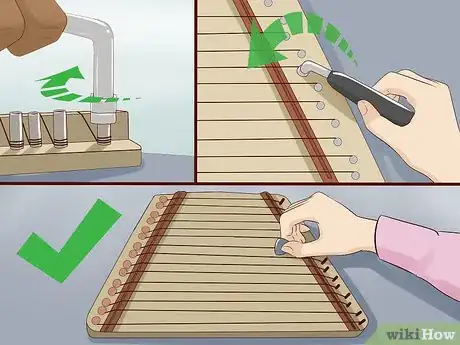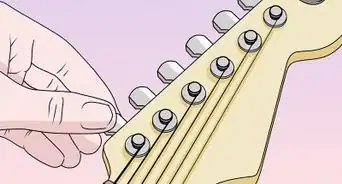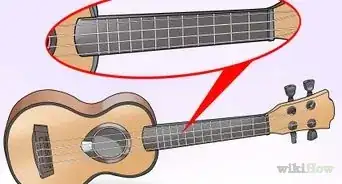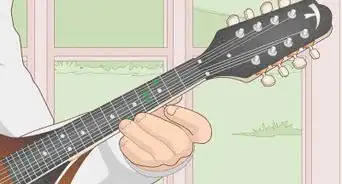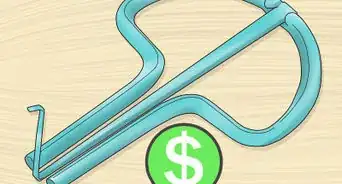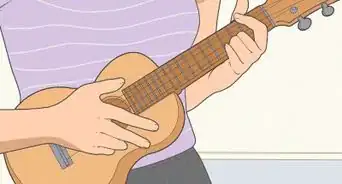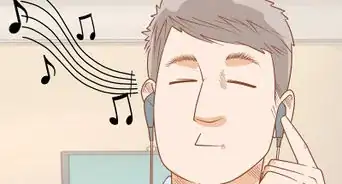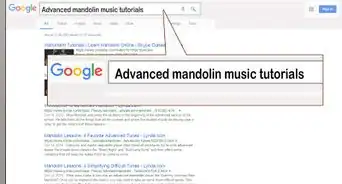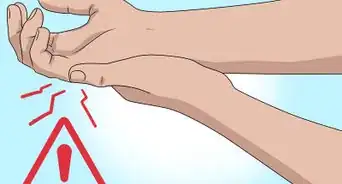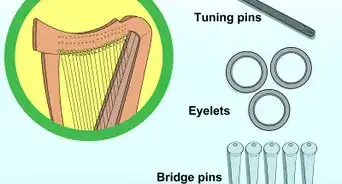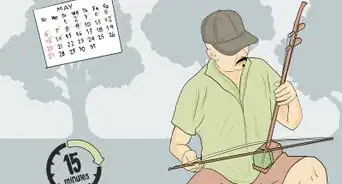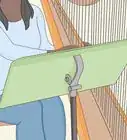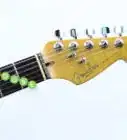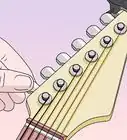This article was co-authored by wikiHow Staff. Our trained team of editors and researchers validate articles for accuracy and comprehensiveness. wikiHow's Content Management Team carefully monitors the work from our editorial staff to ensure that each article is backed by trusted research and meets our high quality standards.
This article has been viewed 142,259 times.
Learn more...
The lap harp—a small string instrument in concert pitch that is popular with young children—can be a wonderful first instrument to learn. It's also a favorite of experienced music students and musicians. But regular play, occasional use, and even a lack of play—which typically leads to dust buildup—can cause the pegs to gradually unwind and pull the whole instrument out of tune. Luckily, with a bit of musical knowledge and a lot of patience, the lap harp is fairly easy to tune.
Steps
Setting up Your Tuner
-
1Purchase a tuning key, electronic tuner, and guitar pick. Most lap harp kits and electronic tuners include a tuning key—a small "L"-shaped silver instrument with a hole that fits over the tuning pegs on the sides of the instrument. Tuners either clip to the body of the harp or are placed close to the harp to pick up its sound. After fitting the key onto a tuning peg, turning the handle changes the key of each string.[1]
- A pick is also recommended to make strumming and note quality easier and better.
-
2Set your tuner to 440 Hz if it's not already. Electronic tuners are often set to this frequency by default. This is sometimes displayed on the tuner as "A = 440." Setting to this frequency means that each of your notes will be the same frequency as other instruments in concert pitch—the common standard for musical instrument tuning.[2]Advertisement
-
3Place the harp on your lap with the narrow, pointed end facing forward. Position it so that are 15 silver pegs on the right of the harp and 15 red pegs on the left. You can also place your lap on a flat surface and tune it from there.
- Sit in a position that is comfortable enough to maintain for a good 15 to 20 minutes.
-
4Clip your electronic tuner onto the harp's wooden body. Most electronic tuners clip onto the body of the harp's wood. Attach it close to the notes that you're tuning and move it accordingly. After clipping it on, turn on the tuner's power and pluck a couple of strings to make sure it's picking up sound signals.[3]
- If you're starting with the G string at the bottom right of the harp, clip it to the bottom right to start and move it along the edge as you continue tuning.
Tuning Your Strings
-
1Strum each string and observe the note on the tuner. Make sure that the display shows the note that the string is playing and a needle that moves to the left or right of its meter display. The screen will also typically display yellow when the note is too low, and red when it's too high. The combination of colors helps you guide your tuning until the needle stabilizes into the center of the display with the desired note above it.[4]
- To tune to G, the notes—from bottom right to top right when the narrow end is facing upward—should be: G, A, B, C, D, E, F, G, A, B, C, D, E, F, G. Alternative tunings are different, but stick to G standard tuning until you get more experience.[5]
- Many lap harps come with a sheet with all the notes marked, as well as tuning instructions. Be sure to have something of this sort (or write down the notes above on a paper) so that you have a reference for what notes each string needs to be tuned to.
-
2Note how many half or whole steps the string is away from the intended note. For example, G♯ (G-sharp) is a half step up from G, and G♭(G-flat) is a half step down from it. Most lap harps are tuned to the key of C or G and only play "natural" notes (no flats or sharps).
- If you're an experienced musician, don't be afraid to play around with some of the strings to turn a note or two flat or sharp.
-
3Tighten each flat string by slowly turning the tuning key clockwise. If the note is too low—for example, the first string is A instead of G—you need to tighten the string a full step. Hook the tuning key onto the silver knob, strum the note clearly until it shows up on the tuner, and then slowly tighten the string with your tuning key by turning it counterclockwise.[6]
- As the note is fading away, you'll hear the pitch begin to change. Use this as a guide as to how much you've changed the sound, and if you're going higher or lower.
- Keep an eye on the tuner screen and stop tightening the string when the tuning needle centers.
-
4Loosen each sharp string by turning the tuning key counterclockwise. If a note has gone sharp—for example, the bottom-right string is A instead of G—hook the tuning key onto the string's peg, strum the note clearly, and gently turn it counterclockwise. Stop loosening the string once the tuner reads G.
- Watch the screen carefully and stop turning the key once the tuner displays the correct note.
- Keep an eye on the tuner screen and stop tightening the string when the tuning needle centers.
-
5Continue this process with all the strings until they're tuned. Tuning can be slow and tedious work, so take plenty of breaks. If you come across a particularly difficult string, come back to it later.[7]
- Check your progress periodically by playing up and down through the strings you've tuned. Make any adjustments as you go along.
Community Q&A
-
QuestionWhat note should each string be tuned to?
 Community Answer"Standard" tuning is the key of G, so starting from the bottom (longest string) the notes should be G, A, B, C, D, E, F Sharp.
Community Answer"Standard" tuning is the key of G, so starting from the bottom (longest string) the notes should be G, A, B, C, D, E, F Sharp. -
QuestionWhat gauge wire is used to restring a harp?
 Tyler MacDonaldCommunity AnswerString gauges can vary depending on the brand and harp, but typically .016.
Tyler MacDonaldCommunity AnswerString gauges can vary depending on the brand and harp, but typically .016. -
QuestionHow much do they cost?
 Tyler MacDonaldCommunity AnswerLap harps usually cost $50 to $100 in USD from online suppliers. They might be a bit more expensive in-store.
Tyler MacDonaldCommunity AnswerLap harps usually cost $50 to $100 in USD from online suppliers. They might be a bit more expensive in-store.
Things You'll Need
- Lap harp
- Electronic tuner
- Tuning key
- Pick
- Note sheet (included in some harp starter kits)
Warnings
- Don't let young children try this unsupervised. It's very likely that they'll over-tighten and break a string, which can be dangerous and present a choking hazard.⧼thumbs_response⧽
- Do not over-tighten the strings! It's very easy to break strings on a lap harp, and it can be a real pain to buy replacement strings.⧼thumbs_response⧽
References
- ↑ https://ourpastimes.com/how-to-tune-a-15-string-lap-harp-12451130.html
- ↑ https://ourpastimes.com/how-to-tune-a-15-string-lap-harp-12451130.html
- ↑ https://youtu.be/en8crJa5quQ?t=59s
- ↑ https://youtu.be/en8crJa5quQ?t=51s
- ↑ http://www.celticharper.com/tuneharp.html
- ↑ https://youtu.be/en8crJa5quQ?t=1m9s
- ↑ https://ourpastimes.com/how-to-tune-a-15-string-lap-harp-12451130.html
